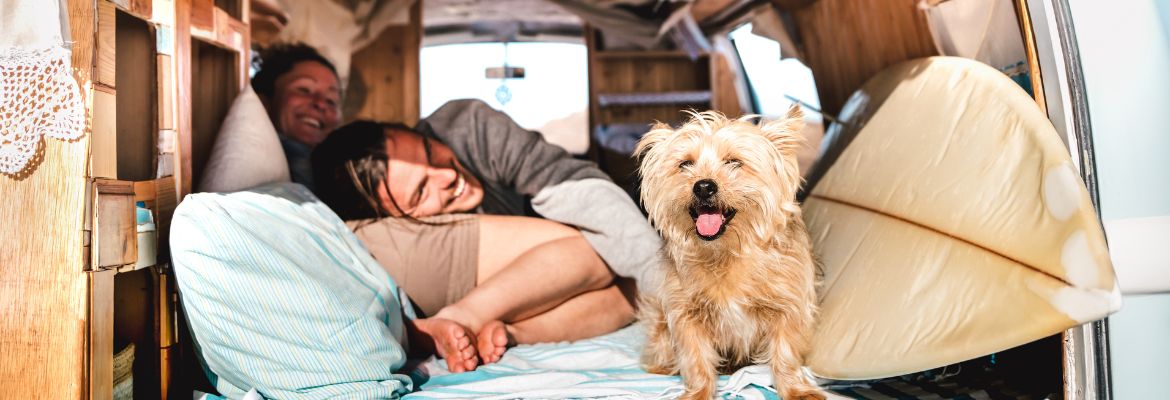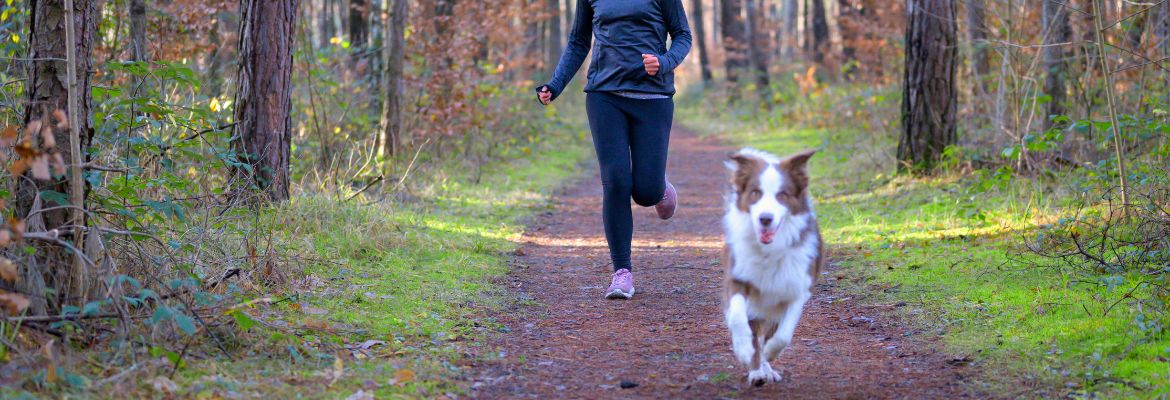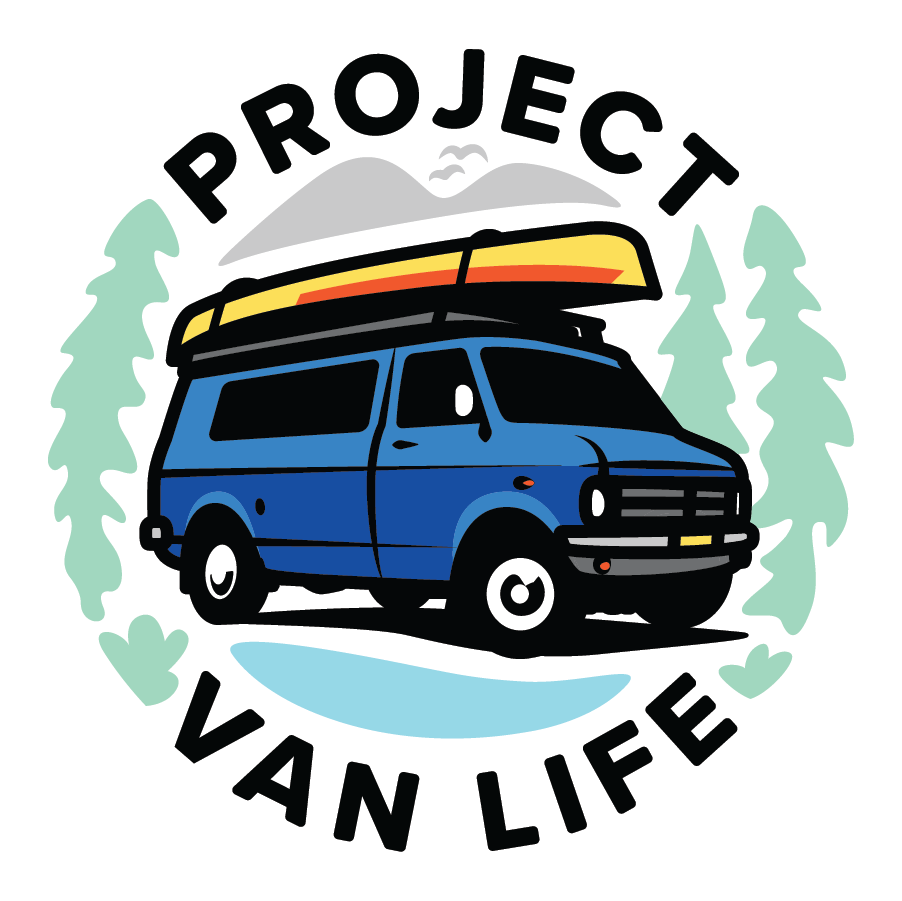The constrained spaces inside of a van are tough enough for one or two humans. But adding in little humans or pets makes things a little trickier. Below we are going to look at each obstacle and some thoughts on accomplishing the seemingly impossible.
Maybe you started the van life as a cutesy couple, filling Instagram with your aspirational adventures. Your days were filled with coffee shops in the morning, wineries in the evening, and adventure in between. You were the envy of your friends. Then you added a pup and a child, and now you’re trying to figure it all out.
Boondocking with Your Favorite Pup
There are plenty of people who experience van travel—and van dwelling—with their favorite canine by their side. Nearly seven in ten RVers travel with a pet on board, and the vast majority of those are dogs. But it isn’t exactly a perfect scenario. There are some definite pros and cons. But our opinion is that the pros outweigh the cons. Let’s look at some of the most commonly asked questions about boondocking with pets.

Will a dog take up too much space in your van?
“Too much” depends on how much you value having your pup with you. If you are a true dog-lover, you’ll find a way to make it work because they are a part of the family. But if you don’t have a dog and aren’t sure, you might want to reconsider.
Dogs can take up a significant amount of space, depending on the breed. In addition to the space they take up is the amount of things you need to be able to take care of those pups. Water bowls, food bowls, dog food, leash, pet-waste bags, a brush, toys, dog bed, medication, etc. These things can take up a lot of space, but most pet-parents love having their dogs with them anyway.
Where does the dog sleep?
If you survey van dwellers with pets, the majority will tell you they sleep in the bed. Some people aren’t ok with this, but the big dog-lovers don’t seem to care. They realize there aren’t a lot of other options, and just deal with it.
What do you do with the dog when you go somewhere you can’t take them—coffee shop, restaurant, etc.?
This is easier in certain seasons than it is in others. During the spring and fall, it’s a little easier to leave the dogs in your van. Afterall, you’ve insulated the van and have two roof vents to keep air flowing through. If you start it out cool, add fans to keep the temperature regulated, and put up sun shades over all the windows, you’ve taken a lot of steps to keep them safe.
The other way pet parents ensure their dog’s safety is to minimize the activities they do without their pups. And when this is unavoidable, there is the security in having a temperature monitoring system connected to your dog that sends you alerts with changes in the environment. It can send you a text to alert you, and allow you to remedy the problem.
How do you give your dog enough exercise?
This is easier than you might think when boondocking in your van. If you love having a dog with you, it’s probably because you enjoy the adventures you go on together. If this is you, van life with your dog is an easy adjustment. Anytime you get out of the van to go for a walk or a hike, take your pup with you! When you see those crystal clear waters, grab a stick and throw it in the water for your pooch. But realize your van will smell like a wet dog.

Gadgets and accessories to consider
There are some things to help make life with a pup a little easier. Depending on where and when you plan to travel, here is a short list of items to consider purchasing.
Temperature monitoring systems
We wouldn’t say this is an absolute must purchase, but if you are planning on spending a lot of summer days away from your pooch, it probably is a necessity. You should consider a "Link My Pet" monitoring system. It offers tons of useful features to track your pets health, location, activity and more...
Outdoor lead attachment or dog tie
When you find that perfect boondocking location but don’t trust your pup off leash, you’ll need a way to give them some outdoor space. Adding an anchor point to your van conversion for a long tie out—or a tie out stake—will make your life and theirs much better.
On dog-friendly van conversions, you might see an eye hook sticking out of the front or rear bumper to accommodate your pups tie out. Just remember to put your pup in a harness first. This will help avoid any potential choking problems and will keep them from slipping out of their collar.
Temperature regulating systems
This was previously mentioned, but having roof vent fans are great ways to keep your pup and yourself comfortable, regardless of the climate. And if you’re planning on traveling over the summer months—especially in sunny destinations—consider utilizing a portable air conditioner like The Wave by EcoFlow to keep your dogs safe while you leave them behind.
Outdoor dog beds
Sometimes a dog wants to know where they belong. They need “their spot.” If your pup gets used to having a dog bed inside, and can’t seem to calm down outside, consider purchasing an outdoor dog bed. These Chuckit! dog beds are slick like sleeping bags on the outside, and pack into a small sack for storage.
Boondocking with Kids
Kids are just tiny versions of an adult, right? Not exactly. They are tiny humans, but with more chaotic energy, and somehow manage to take up three times the space of one adult. With that being said, a boondocking trip with kids can be super exciting for them—and might release the inner child in you.
Whether these small humans are your kids, nieces and nephews, grandkids, or just family friends, you probably have some questions about how to prepare for them. Don’t worry… we've got answers to your questions, plus some ideas to help get you through.

1) What are the sleeping arrangements like?
Some van layouts have a booth in the back that is made into one large bed. If this is your van's layout, it is common to leave these separate and each have a smaller space to sleep. If your van's layout has a permanent bed, you might consider using your work space to transition into an extra sleeping spot, or even bringing along a tent for the extra people.
2) What about a rainy day?
Rain can be a blast, if enjoyed in the right season. If you are with a child during warmer temperatures, go out and play in the rain and mud puddles! Watch the runoff come down the mountains, watch the fish swarm to the top of the water for what they believe to be bugs, or even go creek stomping—wear shoes and traipse through the creek.
Now if there is severe weather like a thunderstorm or flooding, that is very different. Being stuck inside while boondocking can be a bit tough. This is when you might bust out the electronics and watch a movie together—but this only lasts so long. If you find the entire day is a wash out, you might have to vacate your boondocking location and head into town for some fun.
3) How do you handle all the energy in such a small space?
You don’t. You get out and explore. A good rule for dealing with small humans is to plan to wear them out before they wear you out. A well-executed—yet flexible—plan goes a long way when boondocking with kids. Hiking, fishing, swimming, watersports, and a lot of sunshine will wear these kiddos out in a hurry. If you plan the day right, you’ll both have a great time, they’ll get worn out first, and then you can both rest and relax.
But then there is that second wave of energy, right? Plan for it. Know it is coming, and mentally be aware that you won’t have the same experience with them as you do without them. But learn to cherish the occasion. They aren’t with you all the time, and these moments are precious. Make them memorable.
4) Plan for extra resources like water, electricity, food, etc.
Little humans don’t just monopolize space. You will need to consider their usage of the resources like freshwater, electricity, food storage, and tank usage. If you are planning a longer boondocking stay, you might want to plan in a few extra stops at the grocery store.

